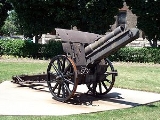
15 cm sFH 13
Encyclopedia
The 15 cm schwere Feldhaubitze 13 (15 cm sFH 13) was a heavy field howitzer
used by Germany
in World War I
and World War II
.
The British referred to these and their shells as "5 point 9"s or "5 9"s as the bore was 5.9 inches (149.9 mm). The ability of these guns to deliver mobile heavy firepower close to the frontline gave the Germans a major firepower advantage on the Western Front early in World War I, as the French and British lacked an equivalent. It was not until late 1915 that the British began to deploy their own 6 inch 26 cwt howitzer.
Guns turned over to Belgium
and the Netherlands
as reparations after World War I were taken into Wehrmacht
service after the conquest of the Low Countries as the 15 cm sFH 409(b) and 406(h) respectively.
Howitzer
A howitzer is a type of artillery piece characterized by a relatively short barrel and the use of comparatively small propellant charges to propel projectiles at relatively high trajectories, with a steep angle of descent...
used by Germany
Germany
Germany , officially the Federal Republic of Germany , is a federal parliamentary republic in Europe. The country consists of 16 states while the capital and largest city is Berlin. Germany covers an area of 357,021 km2 and has a largely temperate seasonal climate...
in World War I
World War I
World War I , which was predominantly called the World War or the Great War from its occurrence until 1939, and the First World War or World War I thereafter, was a major war centred in Europe that began on 28 July 1914 and lasted until 11 November 1918...
and World War II
World War II
World War II, or the Second World War , was a global conflict lasting from 1939 to 1945, involving most of the world's nations—including all of the great powers—eventually forming two opposing military alliances: the Allies and the Axis...
.
History
Variants were the original "kurz" (L/14 - 14 caliber short barrel version); later lg. sFH13 with a longer barrel; and lg. sFH13/02 with modifications to simplify wartime manufacture of the lg. sFH.The British referred to these and their shells as "5 point 9"s or "5 9"s as the bore was 5.9 inches (149.9 mm). The ability of these guns to deliver mobile heavy firepower close to the frontline gave the Germans a major firepower advantage on the Western Front early in World War I, as the French and British lacked an equivalent. It was not until late 1915 that the British began to deploy their own 6 inch 26 cwt howitzer.
Guns turned over to Belgium
Belgium
Belgium , officially the Kingdom of Belgium, is a federal state in Western Europe. It is a founding member of the European Union and hosts the EU's headquarters, and those of several other major international organisations such as NATO.Belgium is also a member of, or affiliated to, many...
and the Netherlands
Netherlands
The Netherlands is a constituent country of the Kingdom of the Netherlands, located mainly in North-West Europe and with several islands in the Caribbean. Mainland Netherlands borders the North Sea to the north and west, Belgium to the south, and Germany to the east, and shares maritime borders...
as reparations after World War I were taken into Wehrmacht
Wehrmacht
The Wehrmacht – from , to defend and , the might/power) were the unified armed forces of Nazi Germany from 1935 to 1945. It consisted of the Heer , the Kriegsmarine and the Luftwaffe .-Origin and use of the term:...
service after the conquest of the Low Countries as the 15 cm sFH 409(b) and 406(h) respectively.
See also
- 6 inch 26 cwt howitzer British equivalent
- Canon de 155 C modèle 1917 SchneiderCanon de 155 C modèle 1917 SchneiderThe Canon de 155 C modèle 1917 Schneider, often abbreviated as the C17S, was a French howitzer designed by Schneider et Cie. It was essentially the Canon de 155 C modèle 1915 Schneider fitted with a different breech to use bagged propellant rather than the cartridge cases used by the older howitzer...
French equivalent
In literature
- Siegfried SassoonSiegfried SassoonSiegfried Loraine Sassoon CBE MC was an English poet, author and soldier. Decorated for bravery on the Western Front, he became one of the leading poets of the First World War. His poetry both described the horrors of the trenches, and satirised the patriotic pretensions of those who, in Sassoon's...
expressed the British respect for the "five-nine" in his World War I poem Counter-Attack - Timothy FindleyTimothy FindleyTimothy Irving Frederick Findley, OC, O.Ont was a Canadian novelist and playwright. He was also informally known by the nickname Tiff or Tiffy, an acronym of his initials.-Biography:...
mentions "5.9s" in his book The WarsThe WarsThe Wars is a 1977 novel by Timothy Findley telling the story of a young Canadian officer in World War I. First published by Clarke Irwin, it won the Governor General's Award for fiction in 1977.-Plot overview:... - Wilfred OwenWilfred OwenWilfred Edward Salter Owen MC was an English poet and soldier, one of the leading poets of the First World War...
mentions being shelled by "Five-Nines" in his poem Dulce et Decorum estDulce et Decorum EstDulce et Decorum est is a poem written by poet Wilfred Owen in 1917, during World War I, and published posthumously in 1920. Owen's poem is known for its horrific imagery and condemnation of war. It was drafted at Craiglockhart in the first half of October 1917 and later revised, probably at...
.

